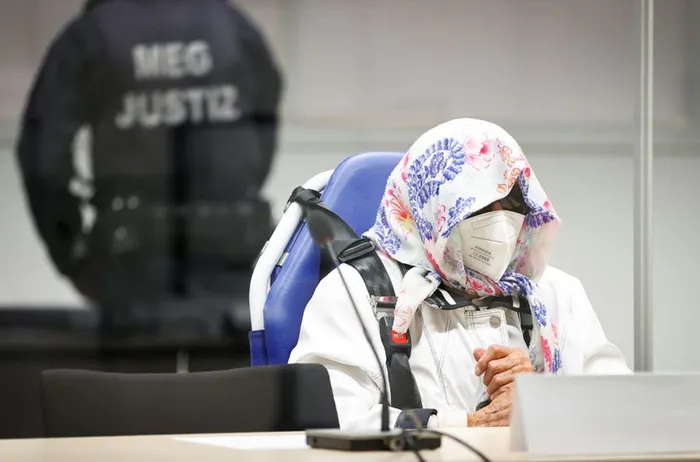In latest death camp case, German court gets the biggest question right

Picture: Christian Charisius/Pool via REUTERS - Irmgard Furchner, a 96-year-old former secretary to the SS commander of the Stutthof concentration camp, is pictured at the beginning of her trial in a courtroom, in Itzehoe, Germany, October 19, 2021.
By Lawrence Douglas
This month, a German court convicted Irmgard Furchner as an accessory to the murder of 10,505 people. From 1943 to 1945, Furchner served as the secretary to the commandant of Stutthof, an SS concentration camp in Nazi-occupied Poland. Bizarrely, because the 97-year-old defendant had begun her secretarial duties at 18, she was tried in juvenile court. Partly for this reason, the court gave a lenient sentence of two years, suspended. Furchner might be the last person convicted of taking part in the Nazis' annihilation of 6 million European Jews.
The legal reckoning with the Holocaust began early, even before the war ended, with the Soviet trials of perpetrators of mass murder in Krasnodar and Kharkov in 1943. The following years and decades witnessed several of the most resonant trials of the 20th century: the Nuremberg trial of the major Nazi war criminals, the first international criminal proceeding in history, in 1945-46; the 1961 Jerusalem trial of Adolf Eichmann, the logistical mastermind behind the deportation of Jews to SS killing centers; and the 1987 French trial of former Gestapo officer Klaus Barbie, the so-called "butcher of Lyon."
In comparison with these historic trials, the Furchner proceeding, with its suspended sentence of a nonagenarian tried as a juvenile, might appear to be a strange denouement. Yet the value of the verdict should not be overlooked.
In an important sense, this case brings the pursuit of justice for the Holocaust full circle. As early as 1950, in the trial of two officers at Sobibor, an SS killing facility in eastern Poland, a court in Frankfurt held that everyone active at the camp had been "linked to a single process whose sole purpose was the killing of Jews." The court insisted that even those SS men who had worked in the camp's bakery and the Schuhkommando - the group in charge of collecting, sorting and storing the shoes of the murdered Jews - bore responsibility for "the success [of the killing operation]."
But no other German court followed this lead. In 1969, in a disastrous ruling, the Bundesgerichtshof (BGH), Germany's highest appellate court, failed to conceive of Auschwitz as a unified criminal complex in which the complicity of all those who had worked in the camp could be imputed. Instead, the court treated Auschwitz as a site in which many thousands of discrete crimes occurred, each of which needed to be independently proved. This ruling created huge obstacles to the successful prosecution of camp functionaries, especially because the German statute of limitations had long tolled on all Nazi-era crimes with the exception of homicide. Without evidence of a specific act of homicide by a named camp functionary, prosecution was essentially impossible. Those inclined to cynicism might say that was exactly the point. In any case, for decades, Germany's prosecution of former camp guards ground to halt.
The conviction of John (Ivan) Demjanjuk by a Munich court in 2011 marked a belated break with this regrettable case law. In convicting Demjanjuk, the court recognized that all guards at an SS killing center, such as Sobibor where Demjanjuk served, were accessories to murder - because that had been their job. In such cases, the court reasoned, it was unnecessary to provide evidence of a specific act of killing to prove guilt. By working as a guard in a killing center, Demjanjuk's guilt followed lockstep from his function.
Still, the Munich court calculated Demjanjuk's complicity in a strangely aggregated manner. In holding Demjanjuk complicit in the death of about 28,000 Jews, the court imputed the defendant's guilt for each specific transport of Jews that arrived during his months serving at Sobibor. Each transport, the court reasoned, represented a distinct act of complicity and so was treated as a separate count against Demjanjuk. Alas, this conclusion represented the persistence of the flawed understanding embraced by the BGH in 1969. By the reasoning of Demjanuk's judges, Sobibor suddenly and episodically constituted itself as a murder center only when transports arrived. This, of course, was wrong: Sobibor existed as a murder center and the court should have treated Demjanjuk's complicity holistically, not as a collection of aggregate crimes.
Now, in convicting Furchner, the court in the northern German town of Itzehoe has finally embraced a unified understanding of participation. In contrast to the Demjanjuk case, the court treated Stutthof itself as a criminal complex. The court did not deny that Furchner played an extremely minor role in the larger campaign of extermination. In contrast to Demjanjuk, she had not escorted any Jews from the train to the gas chamber; neither had she patrolled a guard tower, preventing escape. But in typing the orders of the commandant, she contributed, however marginally, to the success of the Stutthof camp - a unified and coordinated criminal operation created to destroy people.
Her suspended sentence reflected both her age and her low level of responsibility. But her conviction made clear that participation in an exterminatory system, at whatever level, deserves to be recognized as a crime. In perhaps its last judgment on the Holocaust, a German court finally returned to its early recognition that complicity attaches to all who participate, however peripherally, to a genocidal system.
Lawrence Douglas is chair of the Department of Law, Jurisprudence and Social Thought at Amherst College.
This article was first published in The Washington Post.